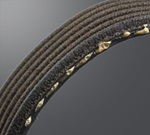Timing belt tracking often causes serious problems, but so does multi-ribbed belt tracking. Some people may know that the latter can even directly affect the timing belt – and, when that happens, a complete engine repair is the only thing that will get the car going again.
What can possibly go wrong?
 A multi-ribbed belt that runs slightly off the pulleys will fray at the edges (though less so than a timing belt, as the ribs tend to keep the accessory belt more firmly in place in the pulley grooves). Perhaps this does not sound like much of a problem, but the consequences can be far-reaching, as we’ve hinted at in the introduction. After all, the sidewalls of the belt will eventually fray and the edge-cords can get caught in the timing belt drive, completely dismantling the auxiliary belt and causing catastrophic engine damage. Alternatively, the multi-ribbed belt may break if it runs along the edge of a pulley for too long and, again, get pulled into the timing belt drive as a consequence.
A multi-ribbed belt that runs slightly off the pulleys will fray at the edges (though less so than a timing belt, as the ribs tend to keep the accessory belt more firmly in place in the pulley grooves). Perhaps this does not sound like much of a problem, but the consequences can be far-reaching, as we’ve hinted at in the introduction. After all, the sidewalls of the belt will eventually fray and the edge-cords can get caught in the timing belt drive, completely dismantling the auxiliary belt and causing catastrophic engine damage. Alternatively, the multi-ribbed belt may break if it runs along the edge of a pulley for too long and, again, get pulled into the timing belt drive as a consequence.
The belt’s rubber sidewalls can also wear off in the long run. This means that the ribs of the multi-ribbed belt get narrower, eventually losing proper contact with the pulley. Such a belt will slip and make a squealing sound. A chirping sound, in turn, is typically caused by misalignment.
What causes belt tracking?
When an accessory belt is shiny or glazed on one side, you know something’s up. As with timing belt tracking issues, serpentine belt tracking is often due to misalignment. Worn pulleys or slightly bent parts (e.g. because of an accident – we’re talking millimeters here, so the issue can easily escape your notice) are enough to cause alignment problems in the long run.
How to detect misalignment?
Both
parallel pulley misalignment (the driver and driven belt pulleys lie in different planes) and
angular pulley misalignment (the driver and driven shafts are not parallel) can be detected using the
DriveAlign® tool. Simply put the tool with the first ‘foot’ in the first groove of the pulley and aim the laser beam at the opposite pulley. Any misalignment will be instantly visible (the laser beam should end up on the second pulley tip).
 Detect parallel pulley misalignment and angular pulley misalignment using the DriveAlign® tool.
Detect parallel pulley misalignment and angular pulley misalignment using the DriveAlign® tool.